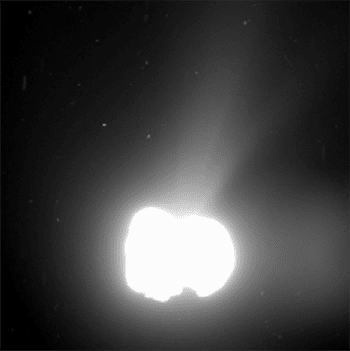New Research Confirms That Comets Are Made Up Of Clathrate Ice
Comets are commonly found celestial objects, made up of water- ice having a distinct gravitationally unbound atmosphere surrounding the core. Though their key constituents are well understood, the exact type of water-ice that permeates comets has intrigued many brilliant minds. Recently, a group of researchers from the Southwest Research Institute (SwRI) has thoroughly tested the data received from the surroundings of the comet 67P/Churyumov-Gerasimenko via ESA's Rosetta spacecraft, which ultimately revealed the type of water ice stored in a comet i.e. crystalline water ice, a clathrate compound.
Dr. Adrienn Luspay-Kuti, lead author and a researcher from SwRI's Space Science and Engineering Division explained that the molecular structure of comets interest them because it enables them to discover it's age. She also mentioned that the crystalline ice signifies that 67P was born from stacked ice close to our Sun. The protosolar nebula witnessed extremes of temperature and pressure, which might be the optimum environment for crystalline ice and clathrate to thrive.

Comet 67P
The report also notified that amorphous water ice could be found in a large volume near the outskirts of the comet. Water clathrates are basically filled with volatile gas molecules, which help in framing a structural design of the clathrate. Luspay-Kuti, the team leader, emphasised on the fact that the promising effort by institutes of international repute had helped them to learn about the origin of cometary nuclei ,which gives several key insights regarding the history of the solar system.
This research was supported by the Jet Propulsion Laboratory, Cornell University, the French National Research Agency, the Centre National d'Études Spatiales and the James Webb Space Telescope project. The complete research report was published on the April 8 issue of the Journal 'Science Advances'.
Source: #-Link-Snipped-#
Dr. Adrienn Luspay-Kuti, lead author and a researcher from SwRI's Space Science and Engineering Division explained that the molecular structure of comets interest them because it enables them to discover it's age. She also mentioned that the crystalline ice signifies that 67P was born from stacked ice close to our Sun. The protosolar nebula witnessed extremes of temperature and pressure, which might be the optimum environment for crystalline ice and clathrate to thrive.

Comet 67P
This research was supported by the Jet Propulsion Laboratory, Cornell University, the French National Research Agency, the Centre National d'Études Spatiales and the James Webb Space Telescope project. The complete research report was published on the April 8 issue of the Journal 'Science Advances'.
Source: #-Link-Snipped-#
0
